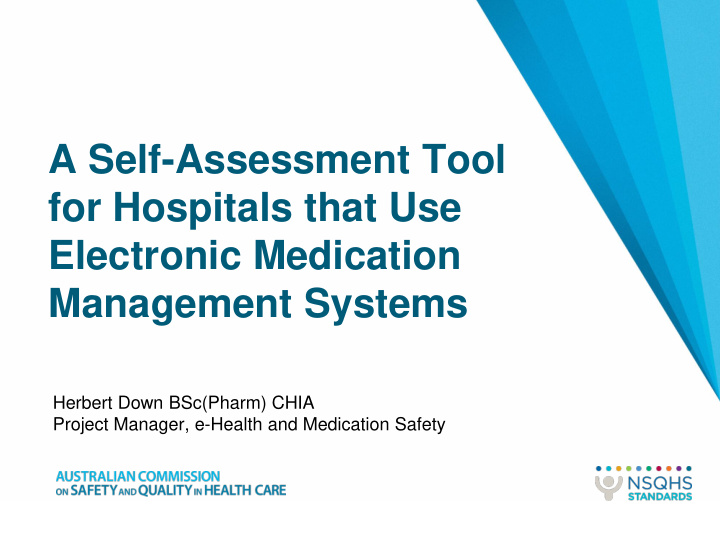



A Self-Assessment Tool for Hospitals that Use Electronic Medication Management Systems Herbert Down BSc(Pharm) CHIA Project Manager, e-Health and Medication Safety
What is the Commission?
The Commission’s Work
NSQHS Standards (second edition) Clinical Governance Standard Partnering with Consumers Standard Preventing and Controlling Healthcare-associated Infection Standard Medication Safety Standard Comprehensive Care Standard Communicating for Safety Standard Blood Management Standard Recognising and Responding to Acute Deterioration Standard
Medication Management Cycle
EMM Guide and Business Requirements
Presentation of information
Lessons Learnt about EMM systems • EMM remains one of the most complex change projects a health service will undertake • Poor project management and unclear communication will deliver a poor implementation • EMM is not a ‘set and forget’ system – go live is just the beginning of the journey to delivering those benefits promised in the original business case • Begin planning for quality improvement and system optimisation from before go-live to avoid the data tsunami
Scoping an EMM SAT • Literature review to identify international examples • Consider the Australian EMM environment • Identify the characteristics of the SAT required to be useful to hospitals taking into account: • Australian medicine safety priorities • Australian EMM system implementations as well as the Australian EMM landscape • Electronic Medication Management Systems – A guide to safe implementation (third edition ) • Some comparable Australian surveys and assessment tools • The NHS England Digital Maturity SAT • The Leapfrog Group CPOE Evaluation tool.
Leapfrog Group
NHS Digital Maturity SAT
Developing the SAT • Health Services Medicines SAT Domains Executive support Expert Advisory Group Governance provides technical advice and Infrastructure Integration of core systems oversight Security of access • Structure of the SAT based Role delineation Useability and workflow optimisation on the approach used in the Medication reconciliation Transfer of care medicines Standards Use of Australian standards • Domains and indicators Clinical decision support EMM policies and procedures • Validation and testing Access and review of EMM data including adverse events, near-miss prescribing events • Workbook and improvement Use of continuous quality improvement to optimise EMM workflow, medication safety, education and training plan template Ongoing EMM support
Benefits of the SAT • Immediate and useful feedback • Monitor, evaluate and improve the EMM system fits with accreditation activities: Standard One - Governance Standard Four - Medication Safety • Structured and standardised approach to system improvement • Potential to share and improve future iterations
Acknowledgements • The Commission would like to the thank the following individuals – Steve Saunders, Principal Consultant, Closed Loop & Associates – Neville Board, Chief Digital Health Officer, Department of Health and Human Services, Victoria.
Herbert Down 02 – 9126 3583 Herbert.down@safetyandquality.gov.au
Recommend
More recommend